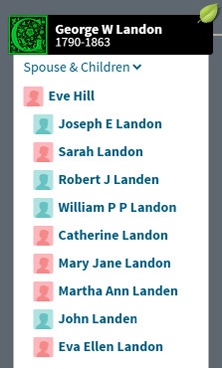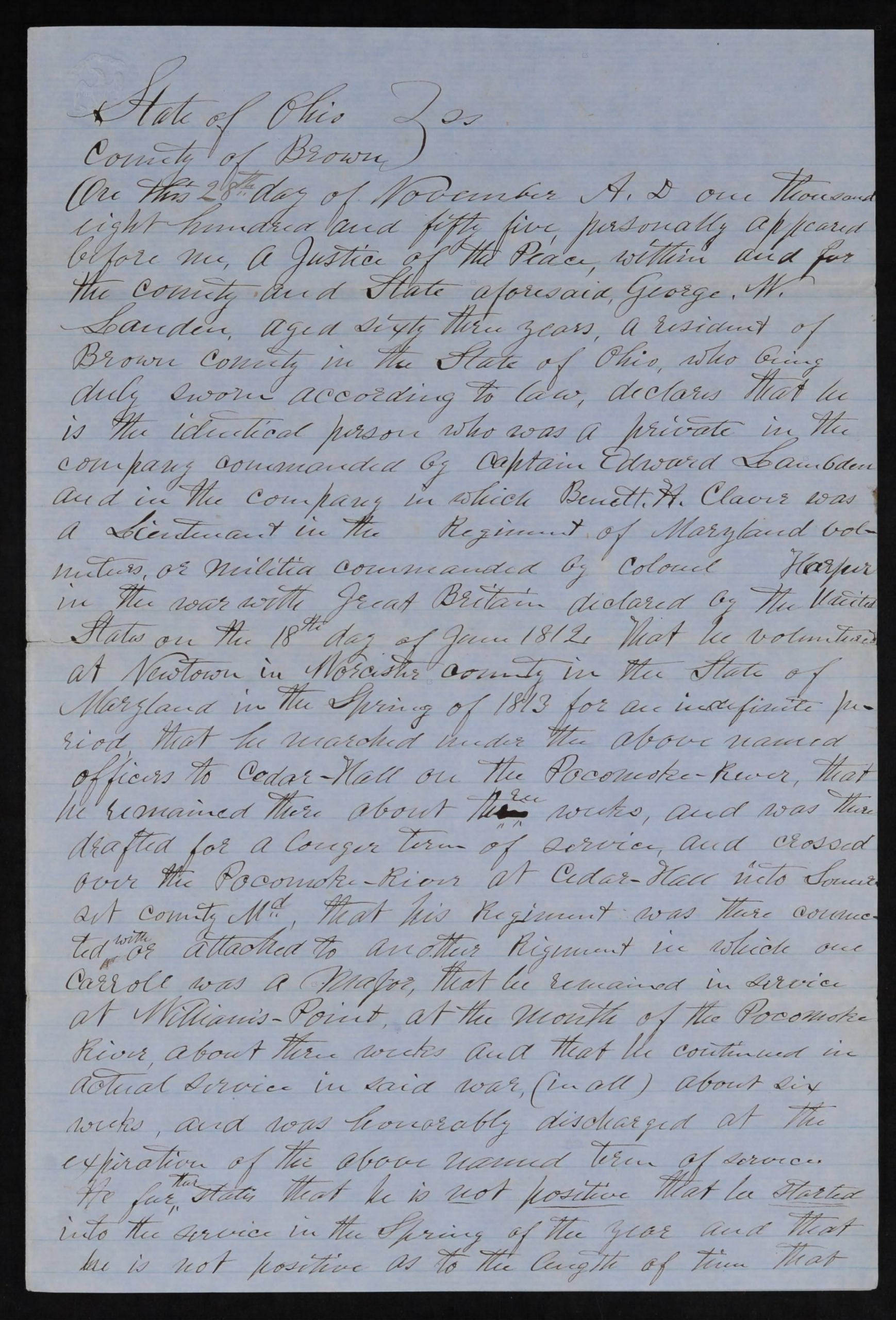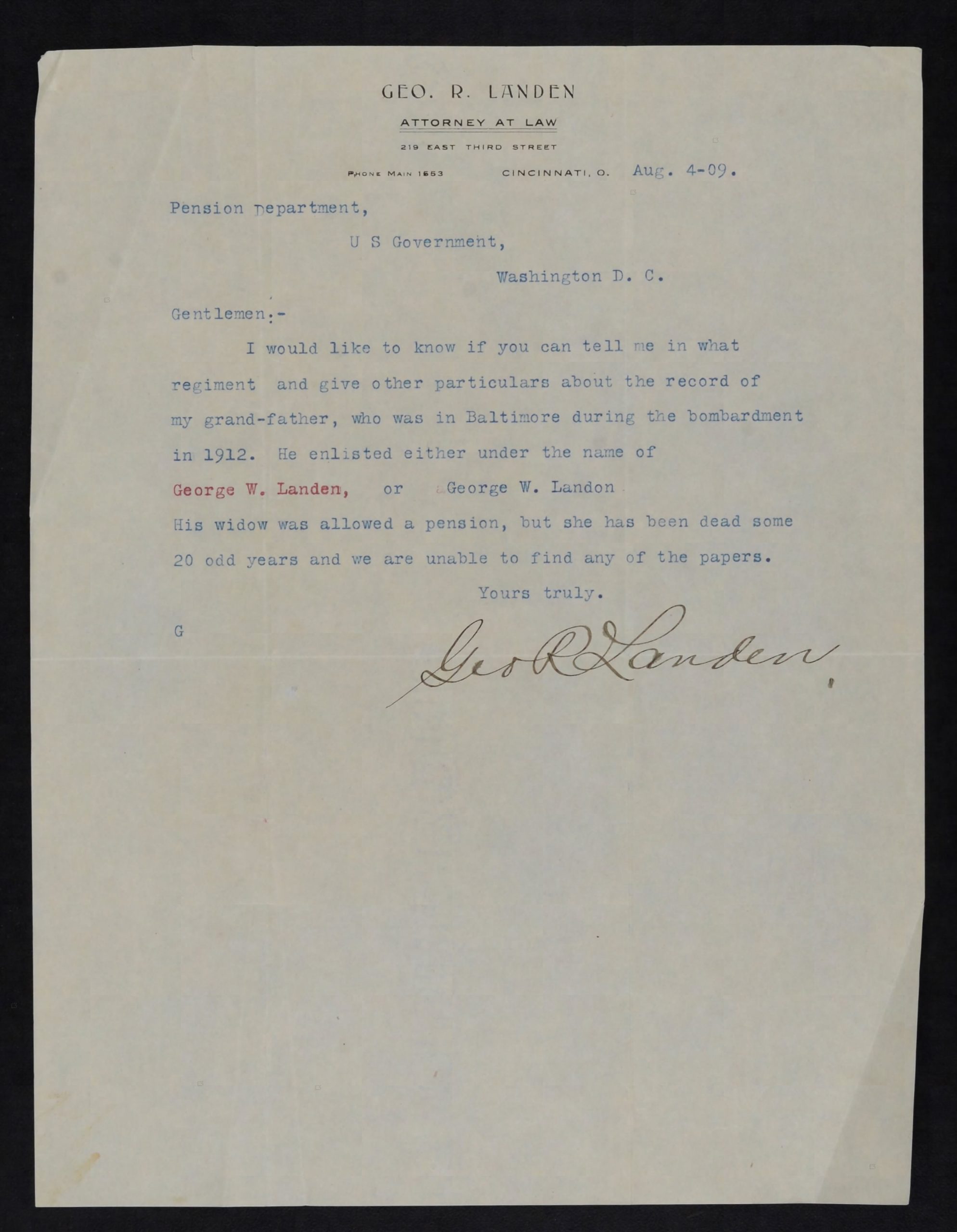
Fire – Rockets Red Glare:
George Landon, 1790-1863
I enjoy putting facts and sources to family oral history. One family legend holds that my 3rd great grandfather, George Landon, (sometimes spelled Landen) and his first wife, Elizabeth Tull, witnessed the famed Battle of Baltimore, fought at Fort McHenry in September 1814 between the United States and Great Britain during the War of 1812. I wondered how this could be true since the Landon’s lived in Worcester County, Maryland, not Baltimore. Worcester County is across the Chesapeake Bay, on the Delmarva Peninsula, from Baltimore, about 100 miles to the southeast. How could they have seen the battle from so far away? [1]
Life in Maryland
George Walston Landon was born sometime during 1790 in Maryland. Although the county of his birth is not documented, many believe it was Somerset County, which is located in the southwestern portion of the Delmarva Peninsula. On 24 September, 1811, George Landon married for his first wife Elizabeth Tull in Worcester County, MD. [2]
War of 1812 Service
George Landon enlisted as a private in Worcester Co., Maryland in the 9th Regiment of the Maryland Militia, commanded by Colonel Harper, for service starting March 1813. [3] Page 18 of the widow’s pension file includes George’s request for bounty land dated 28 November 1855. [4] This request includes a statement which describes his war service as follows:
“…was a private in the company commanded by Captain Edward Lambden (later corrected to Landern) and in the company in which Benett H. Clavir was a Lieutenant in the Regiment of Maryland volunteers or militia commanded by Colonel Harper in the war with Great Britain declared by the United States on the 18th day of June 1812. That he volunteered at Newtown (now Pocomoke City) in Worcester County in the State of Maryland in the Spring of 1813 for an indefinite period, that he marched under the above named officers to Cedar-Hall on the Pocomoke River, that he remained there about three (?) weeks, and was then drafted for a longer term of service, and crossed over the Pocomoke River at Cedar-Hall into Somerset County, Md, that his Regiment was there connected with or attached to another Regiment in which one Carroll (?) was a Major, that he remained in service at Williams-Point at the Mouth of the Pocomoke River about three weeks and that he continued in actual service in said war (in all) about six weeks, and was honorably discharged at the expiration of the above named term of service.”
The statement is longer, but this is the portion that describes his service. The locations in this statement are in the southern part of Maryland on the Delmarva Peninsula. And, at most, covers a period of March to June 1813. This service does not place George Landon near Baltimore in September 1814.
Pocomoke City, MD (Newtown)
Pocomoke City, MD, formerly Newtown
Cedar Hall Wharf, MD
Cedar Hall Wharf on the Pocomoke River
Williams Point, MD
Williams Point at the mouth of Pocomoke River
Maryland’s Peninsula on the Chesapeake Bay
I have consulted with people familiar with the Delmarva Peninsula and they assert it is NOT possible that George could see, or hear, the bombardment of Ft. McHenry from the lower Delmarva. They explained to me there is no direct line of sight between the two points. The terrain between the lower Delmarva and Ft. McHenry, on the mainland side, has bay front cliffs and beyond are hills. Ft. McHenry is located a fair distance up the Patapsco River and not directly on the Chesapeake Bay. The most famous witness to the bombardment of Ft. McHenry was Francis Scott Key. Key observed the battle from a gun-boat just 8 miles away in the Patapsco River.
If George was a witness to the bombardment, then he would need to be closer to the action. What would have taken him to the Baltimore area? Although George was a farmer later in life, he may have performed general labor when he was a young man before he had his own farm. Perhaps he did some sort of labor needed to build the defenses around Baltimore prior to the anticipated attack. Or, maybe he worked for a ship builder in the area. Ships were in great demand during the war period. Or, was George a member of the Chesapeake Flotilla protecting Baltimore during the attack? I have found no documentation to support any of these explanations.
Conclusion
I may never know conclusively if my 3rd great grandfather did witness the bombardment of Ft. McHenry in September 1814. But, I have discovered that the family legend dates back more than 100 years. While researching this story I found a letter written by one of George Landon’s grandsons to the Department of Veteran’s Affairs. In the letter, this grandson is inquiring about his grandfather’s service and he states that George Landon was a witness to the attack on Ft. McHenry. This grandson, who was also George Landon, was born after the death of his grandfather, and namesake, which means he would have had this family legend second-hand, at best.
EPILOGUE
 The Landon family moved to Bracken County, KY prior to 1820. Sadly, Elizabeth died in 1822. George married again, and was widowed again, and again. George married my 3rd great grandmother Eve Hill in 1831 as his 4th wife. The couple moved to Brown County, OH shortly after their marriage and all 9 of their children were born there between 1833 and 1855. The Landon family were successful farmers. According to the 1850 Agriculture schedule they had about 60 acres of developed land, various livestock, feed, produce, and dairy products. [5] I previously wrote about George Landon’s family in a post about Large Families.
The Landon family moved to Bracken County, KY prior to 1820. Sadly, Elizabeth died in 1822. George married again, and was widowed again, and again. George married my 3rd great grandmother Eve Hill in 1831 as his 4th wife. The couple moved to Brown County, OH shortly after their marriage and all 9 of their children were born there between 1833 and 1855. The Landon family were successful farmers. According to the 1850 Agriculture schedule they had about 60 acres of developed land, various livestock, feed, produce, and dairy products. [5] I previously wrote about George Landon’s family in a post about Large Families.
George Landon did receive a Bounty Land Warrant for his War of 1812 service. It was 160 acres in Dickinson County in the upper peninsula of Michigan. He never exercised the warrant and it was assigned away after his death by his estate. Using Google Maps satellite view the tract can be viewed and it is scrub, probably much as it was in 1855. [6] For a time, in addition to farming, George Landon served as post master for his community of White Oak Valley. [7] George died 18 January 1863 and is buried in Unity Cemetery in Brown County, OH. [8]
For more information about Ft. McHenry in the War of 1812 follow these links:
https://www.battlefields.org/learn/war-1812/battles/fort-mchenry
https://www.battlefields.org/learn/articles/o-say-can-you-see-bombardment-fort-mchenry
SOURCES
- Profile for George Walston Landon, ‘Osborn‘ family tree, Ancestry.com;
https://www.ancestry.com/family-tree/person/tree/13493206/person/27556014990/facts - Entry for George Landen, Ancestry.com. Maryland, Compiled Marriages, 1667-1899 [database on-line]. Provo, UT, USA: Ancestry.com Operations Inc, 2000.
- Entry for George Landen, War of 1812 Service Record Index, Fold3.com, “Index to Compiled Service Records of Volunteer Soldiers Who Served During the War of 1812” [database on-line], Original Source: The National Archives, Pub# M602, Roll: M602_0121
Accessed 12 Aug 2020: https://www.fold3.com/image/265/308196633 - Entry for George Walston Landen, War of 1812 Pension Files, Fold3.com, “War of 1812 Pension and Bounty Land Warrant Application Files” [database on-line], Original Source: The National Archives, Roll: RG15-1812PB-Bx2064 Accessed 12 Aug 2020: https://www.fold3.com/image/315008280
- Entry for George W. Landen, U.S. Federal Census, Census Year: 1850; Census Place: Pike, Brown, Ohio; Title: “U.S., Selected Federal Census Non-Population Schedules“ Archive Collection Number: T1159; Roll: 2; Line: 21; Schedule Type: Agriculture; Ancestry.com. U.S., Selected Federal Census Non-Population Schedules, 1850-1880 [database on-line]. Provo, UT, USA: Ancestry.com Operations, Inc., 2010.
- https://www.google.com/maps/@46.1375278,-88.0375776,574m/data=!3m1!1e3
- Entry for George W. Landen, U.S., Appointments of U. S. Postmasters, 1832-1971 [database on-line]. Provo, UT, USA: Ancestry.com Operations, Inc., 2010. This collection was indexed by Ancestry World Archives Project contributors. Original data: Record of Appointment of Postmasters, 1832-1971. NARA Microfilm Publication, M841, 145 rolls. Records of the Post Office Department, Record Group Number 28. Washington, D.C.: National Archives.
- Online Memorial for George Walston Landen, FindAGrave.com; https://www.findagrave.com/memorial/10661498 Accessed: 15 Aug 2020






0 Comments